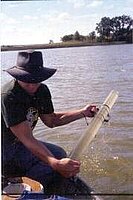Evaluation of invertebrate responses to stocking walleye to suppress fathead minnow populations in Type V wetlands.

Anthony Pothoff has a B.S. in Zoology from North Dakota state University. He pursues his M.S. research in aquatic ecology in wetlands with the support from a Water Institute Fellowship and intends to graduate in the spring of 2003. He hopes to seek a job in the field of research ecology with either a state agency or the federal government.
Anthony is using a vertical column sampler at one of the open water sites.
Fellow: Anthony Pothoff, Department of Biological Sciences, NDSU
Advisor: Malcolm Butler, Professor of Biological Sciences, NDSU
Matching Support: Minnesota Department of Natural Resources, St. Paul, MN
Degree Progress: M.S., May 2003
Progress Todate (November 2002):
Evaluation of invertebrate responses to stocking walleye to suppress fathead minnow populations in Type V wetlands.
The greater depth of many prairie wetlands resulting from consolidation of smaller, more ephemeral wetlands has caused a decrease in the frequency and extent of summer and winter anoxia. As a result, fathead minnows now persist on a more permanent basis, often reaching high population densities, and have been found to reduce zooplankton and macroinvertebrate diversity and abundance. Reductions in zooplankton can in turn lead to increased phytoplankton, decreased water clarity, and reduced macrophyte abundance. Ultimately, these combined changes result in decreased waterfowl use. Innovative, effective ways to control the distribution and abundance of fathead minnow populations in wetlands throughout the Prairie Pothole Region are needed by wetland managers. We designed a two-year study to assess stocking of walleye fry or advanced life-stage walleye as a tool to suppress fathead minnow populations and improve water quality. All wetlands used in the study contained fathead minnow populations. Treatments consisted of 6 wetlands stocked with walleye fry, 6 wetlands stocked with adult walleyes, and 6 wetlands that were left unmanipulated (contained only fathead minnows). Response variables included measurements of the macroinvertebrate and zooplankton communities, turbidity, and multiple water quality parameters. Explanatory variables included fathead minnow biomass, macrophyte abundance, and treatments. The data analysis of the first year of data is complete. To date the majority of analyzes has followed a multivariate approach, specifically ordinations. In addition to using ordinations to analyze the data I will also be using a mixed model ANOVA in SAS to test specific hypotheses.
In the first year of the study we observed a higher density of cladocerans in the walleye fry treatment by mid June, with a 17.5-fold increase over reference wetlands by mid August. Walleye fry stocking appeared to have little effect on most macroinvertebrate populations. The trend of increased zooplankton in the fry treatment, particularly the cladocerans, corroborates our observations that walleye fry were successful in suppressing fathead minnows. This released zooplankton from predation, which led to water clarity improvements in some walleye fry treatment ponds.
I used a partial redundancy analysis (P-RDA) ordination to evaluate my results. The explanatory variables in the RDA are the following: fathead minnows (biomass), plants (abundance), and treatments (fry, advanced, and control). The response variables are the invertebrate abundances. Three key points can be seen in the RDA. First, the majority of invertebrate taxa have a positive association with fry treatment wetlands, an over-all neutral association with control treatment wetlands, and a negative association with advanced treatment wetlands. Second, fathead minnows have a negative association with the fry treatment wetlands, a neutral association with the control treatment wetlands, and a positive association with the advanced treatment wetlands. Third, none of the treatments has a strong positive or negative association with plants.
The results from the first year of the study indicate that the biomanipulation in the fry treatment wetlands responded positively. The positive response can be seen in the decrease in fathead minnow biomass and the increase in cladoceran abundance in the fry treatment wetlands. The response in the advance treatment wetlands was negative, with decreased abundance of most invertebrate groups. The positive results in the fry treatment have potentially set the stage for those wetlands to shift from being in a turbid water state to a clear water state during the second year of the study.
Presentations:
Minnesota Chapter of American Fisheries Society Annual Meeting 2000 - Poster Presentation
North Dakota Wildlife Society Annual Meeting 2002 - Poster Presentation
National Wildlife Society Annual Meeting 2002 - Contributing Paper (Speaker)

Melcolm Butler
Biological Sciences
Office: Research 2, Room 214B
Phone: 701-231-7398
Email: malcolm.butler@ndsu.edu


